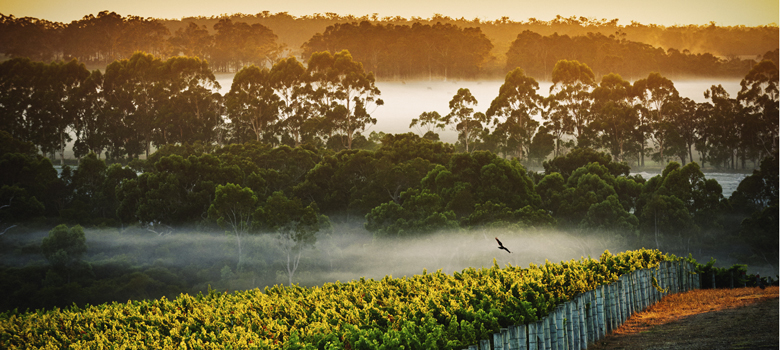
Wine
A Climate for Change
As an elderly Italian gentleman from Griffith reminded me, ‘You cannot have the same pasta every night.’”
This is the analogy Rob Glastonbury, De Bortoli’s operations manager, uses when urging Australian wine consumers to expand their palates and try some of the lesser known grape varieties.
De Bortoli is one of many Australian wine producers exploring more drought-tolerant alternative varieties in a bid to tackle the challenges of a changing climate. Keith Tulloch Wines in the Hunter Valley is another, with Alasdair Tulloch, the company’s carbon neutral spokesperson, saying, “There are a number of (Hunter Valley) vineyards which have now planted grape varieties from Southern France, Italy, Portugal and Spain which are more tolerant to heat and drought. For example, we have Marsanne, Roussanne and Viognier planted on our vineyard estate.”
Additional measures include, as Rob describes, “producing larger ‘shaded’ canopies to protect the fruit from heat and sunburn,” while Alasdair explains that many Hunter vignerons have changed the way they manage irrigation and the application of sunscreen in the vineyard is becoming more common.
Rob also adds, “to manage the faster rate of vintage, we have expanded our intake capacity, installing extra crushing and pressing capacity.”
This is a culmination, he says, of the fact that “over the past 20 years, we have seen the start date of vintages creep forward at about a day and a half per vintage, but more concerning is that the end of vintage dates have also advanced, but at a faster rate of two and a half days. The impact has been both earlier and quicker vintages.”
It’s a similar situation in the Barossa, where, Thorn-Clarke viticulturist Steve Fiebiger says, “older producers share their observations of shorter winters, longer heat spells and earlier starts to budburst and vintage. Watercourses and dams remain low or empty only to flood in a short space of time.”
Climate Projections
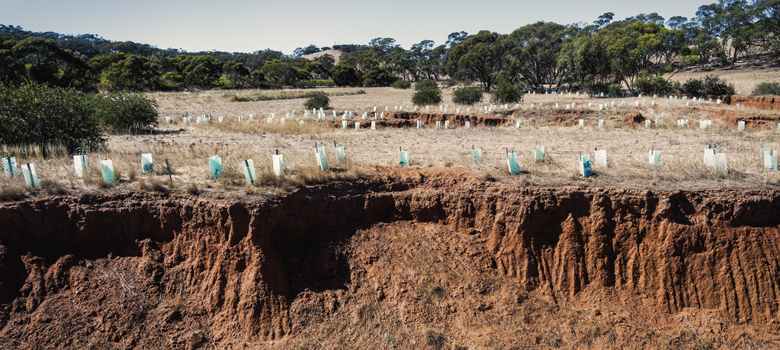
The observations of those in the vines now have comprehensive scientific backing through this year’s publication by Wine Australia of Australia’s Wine Future: A Climate Atlas. This ground-breaking document, produced over three years with the University of Tasmania, aimed, Wine Australia states, “to consider the impact of seasonal climate variability and longer-term climate trends on the wine sector in Australia.”
A free resource, it outlines projected changes for every Australian Geographical Indication in terms of temperature, rainfall and extremes of heat and cold over the next 80 years. Most regions look set to get hotter, some by as much as three degrees by 2100, as well as drier.
These predictions are based on current emissions levels and although many Australian wineries are focussed on doing what they can to survive the predicted increases in heat and aridity, they’re also striving to reduce emissions.
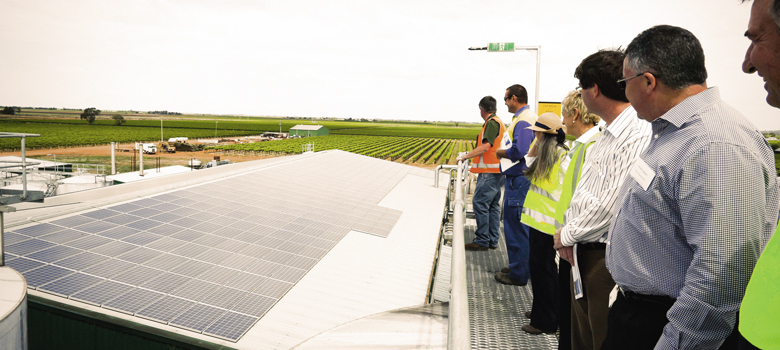
While “the Australian wine industry is a relatively low emitter of greenhouse gases (GHG),” Mardi Longbottom, senior viticulturist at The Australian Wine Research Institute explains, “in vineyards, the largest source of GHG emissions is fuel and electricity use. One way many vineyards have reduced the number of tractor passes through the vineyard each year is to bring sheep into the vineyard during winter. The sheep eat the weeds and reduce the need for slashing the midrows and also reduce the need to control weeds with herbicide.”
In terms of reducing energy for irrigation, Mardi says, this can be done “by watering vines at night to reduce transpirational losses. Many wineries have installed solar energy systems to reduce their reliance on electricity from the grid.”
The list of wineries tackling such changes is impressive with the following just a handful of those dedicated to sustainability.
Among De Bortoli’s many achievements, they have banned sodium on site to help reduce sodium salinity in the Murray Darling Basin. They also collect and farm all waste water, and until recently, Rob describes, “were the largest solar electrical and steam powered array in any winery in Australia – a registered power station, in fact!”
Keith Tulloch Wines is working towards becoming the first Carbon Neutral winery in the Hunter Valley and in doing so have made some inspirational changes. These include using solar for the majority of their power, eliminating single use plastics, using only organic fertilisers and increasing water efficiency through new winery and irrigation processes.
Some of the sustainable achievements of Cape Mentelle in Margaret River include reducing their water consumption by 60 per cent between 2016 and 2019 via precision viticulture. They’re also working towards building a fleet of electric tractors, and they use sheep for both weed control and as a source of fertiliser.
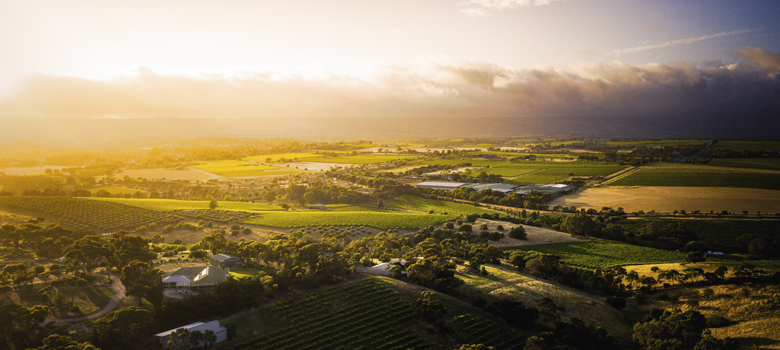
It’s organic all the way at Paxton in McLaren Vale where the vineyards are farmed using biodynamics, a process Brian Lamb, global sales and marketing director, believes, “is best for human consumption and our environment and the best way forward.”
While at Thorn-Clarke, viticulturist Steve Fiebiger says the implementation of sustainable practices, “has been ongoing work in progress from the first development of the vineyards in the 1990s involving planting native tree shelter belts and corridors extending to protecting and rehabilitating the watercourses on the properties.”
Return on Investment
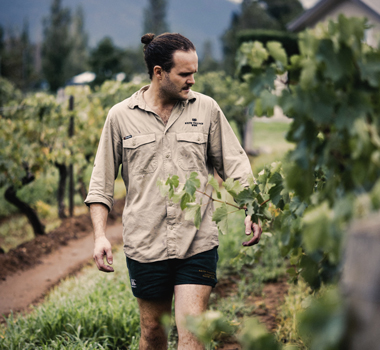

The cost involved in making sustainable changes such as these can be great, but Alasdair believes the payoffs are worth it. Measures such as the use of solar and the elimination of artificial fertilisers, he says, have had great financial returns.
Alasdair also says the changes have required a human investment. Emissions reduction is, he says, “as much a cultural shift as it is a practical shift.”
To this end, he describes, “At the vineyard and winery, each member of or team has taken real ownership of how they interact with the environment and have been drivers of change within their personal and professional lives. This culture is an absolutely essential grain of success for our achievements.”
One of the greatest returns, however, would have to be wine quality. As Steve describes, “The use of mulches and compost has improved wine quality by a variety of means including improved water management, less soil temperature extremes, better vine root environment, more diverse soil biology and mineral nutrition. This expresses itself in fruit that maintains freshness, with a greater concentration of colour, flavour and aroma.”
Cape Mentelle winemaker Ben Cane reports similar improvements. “Through better vine balance, we have an increase in concentration and complexity plus earlier physiological ripening. Berry size is smaller (more concentration), bunch architecture is looser and skins are thicker (giving greater disease resistance), plus colours and tannins ripen quicker and with greater intensity.” The result, he says, is “better expression from our sites of both vineyard and season, with flavour developing earlier allowing us to retain more natural acidity with greater concentration of varietal characters. Better wine!” an optimistic outlook
Talking to the wine producers cited here, there’s great optimism for the Australian wine industry, despite the seriousness of the predictions outlined in the Climate Atlas. As Mardi states, “As an industry we are resilient, especially because of our ability to respond to change.”
And Ben agrees, saying, “In general, we are quite progressive and forward thinking. We are in the most exciting time for Australian wine ever as we have a broader choice of varieties and styles than ever before, with a greater focus on minimising our carbon footprint as well as maximising the quality and complexity of our wines.”